
The cicadas are a superfamily, the Cicadoidea, of insects in the order Hemiptera. They are in the suborder Auchenorrhyncha, along with smaller jumping bugs such as leafhoppers and froghoppers. The superfamily is divided into two families, the Tettigarctidae, with two species in Australia, and the Cicadidae, with more than 3,000 species described from around the world; many species remain undescribed.

Hemiptera is an order of insects, commonly called true bugs, comprising over 80,000 species within groups such as the cicadas, aphids, planthoppers, leafhoppers, assassin bugs, bed bugs, and shield bugs. They range in size from 1 mm (0.04 in) to around 15 cm (6 in), and share a common arrangement of piercing-sucking mouthparts. The name "true bugs" is often limited to the suborder Heteroptera.
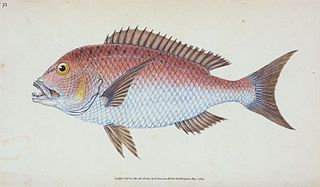
Edward Donovan was an Anglo-Irish writer, natural history illustrator, and amateur zoologist. He did not travel, but collected, described and illustrated many species based on the collections of other naturalists. His many books were successful in his time. He died penniless in 1837 leaving a large family destitute.

Leafhopper is the common name for any species from the family Cicadellidae. These minute insects, colloquially known as hoppers, are plant feeders that suck plant sap from grass, shrubs, or trees. Their hind legs are modified for jumping, and are covered with hairs that facilitate the spreading of a secretion over their bodies that acts as a water repellent and carrier of pheromones. They undergo a partial metamorphosis, and have various host associations, varying from very generalized to very specific. Some species have a cosmopolitan distribution, or occur throughout the temperate and tropical regions. Some are pests or vectors of plant viruses and phytoplasmas. The family is distributed all over the world, and constitutes the second-largest hemipteran family, with at least 20,000 described species.
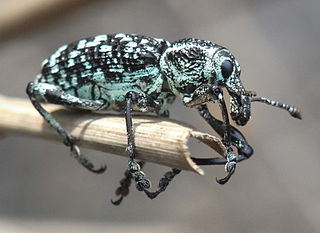
Chrysolopus spectabilis is a species of weevil found in south-eastern Australia. It was discovered during James Cook's first voyage, and became one of the first insects to be described from Australia. The weevil measures up to 25 mm (1.0 in) long and includes distinctive metallic green and black scales. It is found only on 28 species of the plant genus Acacia.
Walter Wilson Froggatt was an Australian economic entomologist.

The chorus cicada, Amphipsalta zelandica, is the most common species of cicada in New Zealand, where it is endemic and found in most areas. They typically live in forests and areas with open bush, where their left-over nymph skins can be seen on tree trunks and branches during the summer months. The males produce their cicada sound in unison, which can reach deafening proportions at the height of their population around February. Groups of cicada can suddenly transition from the typical cicada sound to synchronised clicks, using their wings to clap against the surface they are sitting on.
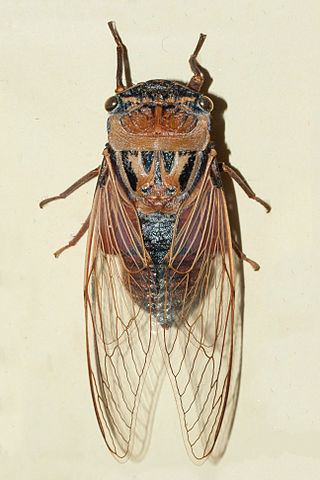
Thopha saccata, the double drummer, is the largest Australian species of cicada and reputedly the loudest insect in the world. Documented by the Danish zoologist Johan Christian Fabricius in 1803, it was the first described and named cicada native to Australia. Its common name comes from the large dark red-brown sac-like pockets that the adult male has on each side of its abdomen—the "double drums"—that are used to amplify the sound it produces.

Psaltoda moerens, commonly known as the redeye, is an Australian species of cicada. It is distributed through the south-east of Australia, from southern Queensland to South Australia, as well as Tasmania. Populations can vary greatly between years; one year they may be present in large numbers and the next they may be entirely absent. They feed primarily on eucalyptus but also on Angophora trees. As they feed on tree sap they expel small droplets of clear waste fluid. When numbers are high, this can form a constant stream.
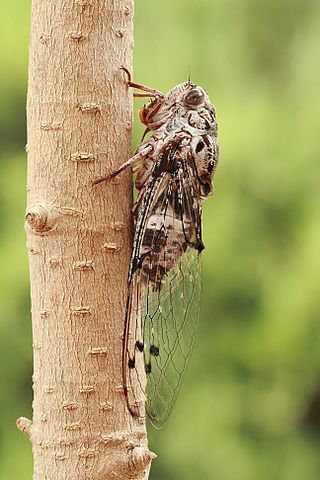
Aleeta curvicosta is a species of cicada, one of Australia's most familiar insects. Native to the continent's eastern coastline, it was described in 1834 by Ernst Friedrich Germar. The floury baker is the only described species in the genus Aleeta.

Psaltoda plaga is a species of cicada native to eastern Australia, from Maryborough in central Queensland to Bega in southern New South Wales. Adult cicadas appear over the summer and inhabit forested areas near bodies of water. The predominantly black form from the Sydney and Central Coast regions is commonly known as the black prince, while the term silver knight is used for the species as a whole.

Eupoecila australasiae, commonly known as the fiddler beetle or rose chafer, is a colourful green- or yellow-and-black member of the scarab beetle family from eastern Australia.

Anoplognathus viridiaeneus, commonly known as the king Christmas beetle, is a beetle of the family Scarabaeidae native to eastern Australia. The largest Christmas beetle, it can be over 3 centimetres (1.2 in) long.

Cyclochila virens, commonly known as the northern greengrocer, is a species of cicada native to northeastern Queensland.

Cyclochila is a genus of cicada native to eastern Australia. Two species are recognised, the greengrocer and the northern greengrocer.

Macrotristria angularis, commonly known as the cherrynose, is an Australian cicada native to eastern Australia, where it is found in sclerophyll forests.
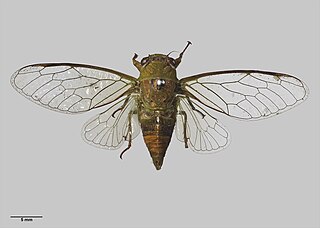
Kikihia ochrina is a species of insect endemic to New Zealand. This species has a three-year life cycle and adults are bright green in colour and are most commonly seen in the month of April in the North Island.

Yoyetta is a genus of cicadas in the family Cicadidae. The genus was erected in 2012 to accommodate nine Australian species previously assigned to the genus Cicadetta.
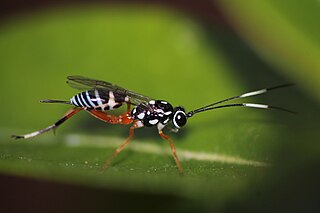
Glabridorsum stokesii is a species of parasitoid wasp belonging to the family Ichneumonidae first described by Peter Cameron in 1912, known to be a generalist parasite of species including crop pest species such as the codling moth and Grapholita molesta. The species is native to southeastern Australia, and has been introduced to New Zealand.




















